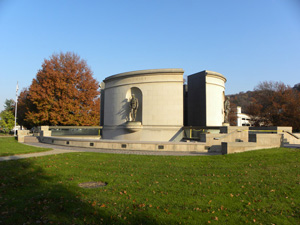

Remember...
Harry Huling Simon
1922-1944
"In War: Resolution. In Defeat: Defiance. In Victory: Magnanimity. In Peace: Good Will."
Winston Churchill
 |
Remember...Harry Huling Simon
|
Harry Huling Simon was born on February 17, 1922, to Alice and Adlai Cleveland Simon. According to his enlistment records, Harry Simon was born in Ohio, but census records indicate that all family members were born in West Virginia. In 1930, the family was living in or near Philippi in Barbour County. Mr. Simon was a coal miner. Harry Simon's siblings, still living at home in 1930, were Helen, Eloise, Earl, James, and Frank.
Harry Simon attended Philippi High School for three years. He married Betty Digman, and they, according to an article in the Philippi Republican about the Simons' sons' military service, had a young daughter at the time the article was published. The family was living in Maryland by 1943. Harry Simon worked for Glenn L. Martin Corporation, an aircraft company. The occupation code applied at the time of his enlistment was "unskilled machine shop and related occupations."
Harry Simon enlisted in the military on May 3, 1943, in Clarksburg. He was placed with Company C, 272nd Infantry Regiment, 69th Infantry Division, and then with Company E, 39th Infantry Regiment, 9th Infantry Division.
The 39th had been in Europe since October 1942. The first mission of the 39th was to secure the northern coast of Africa. They landed on beaches near Algiers on November 8, 1942. They guarded a 300-mile front to protect the Allied supply chain routes, from Algiers to Tunisia. Soon after, they went from guarding a route to playing a leading role in gaining control of North Africa. In November 1943, they were headed for England, where they trained in preparation for their role in the Normandy D-Day invasion. The 39th landed on Utah Beach on June 10, 1944. Since Harry Simon enlisted in May 1944, he may have been with the unit in time for the invasion of France.
For the remainder of the summer, the 39th was a part of the Allied forces that moved across France to Germany, as described on the 9th Infantry Division in World War II website in the history of the 39th Infantry Regiment:
By August 19th, 1944, the 39th Regiment was posed for the drive to the Seine River and Paris. By the 26th of August, the Seine River was reached. The 39th then moved north-eastward and sealed off the Mons Pocket. It then wheeled eastward into Belgium. On September 13th, 1944, the 39th Regiment swept forward to begin a long and costly drive through the Hurtgen Forest in Germany. It moved past the Dragon Teeth (anti-tank constructions made out of cement blocks) and closed in on the fortified town of Roetgen, Germany. On September 14th, the town fell to the 39th and would be the first German city captured in World War II. Day by Day throughout the rest of September, October and the first week of November, the 9th Infantry Division battled its way through the Hurtgen Forest. These were terrible fights, and often named the "worst of all battles" according to many veterans of this Division. ("39th Infantry Regiment," 9th Infantry Division in WW2, accessed 1 November 2021, https://9thinfantrydivision.net/39th-infantry-regiment/.)
The Hurtgen Forest is east of the Belgian-German border. It ended up being the longest battle on German territory during World War II and is the longest single battle the U.S. Army has ever fought. ("Battle of the Hurtgen Forest," Europe Remembers, accessed 1 November 2021, https://europeremembers.com/story/battle-of-huertgen-forest/.) The environment and weather perhaps played a role in this milestone. The fall and winter of 1944 in this area were marked by heavy rain and then snow. The forest was composed of woods, bare hilltops and gorges, and there were no or insufficient roads. Despite this, the Allies pushed to the Rhine. The battle finally came to a close in December 1944.
Harry Simon did not see the end of the Battle of the Hurtgen Forest. Harry Simon's hospital records indicate that he died as a casualty of battle from injuries inflicted by artillery shell or artillery shell fragments. He died on September 20, 1944, only a day into the fierce battles in the Hurtgen Forest.
Two of Harry Simon's brothers also served in the military during World War II. Earl served with the Army Air Corps and was stationed at Napier Field, Alabama. Frank was a Pharmacist's Mate 2nd Class with the Navy at the Navy Base Hospital, Honolulu, Hawaii.
Article prepared by Cynthia Mullens
November 2021

West Virginia Archives and History welcomes any additional information that can be provided about these veterans, including photographs, family names, letters and other relevant personal history.